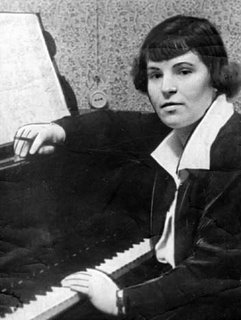The Lady with The Hammer

Unusually simple piano scores scatter the studio floor of a reclusive composer in St. Petersburg. Galina Ustwolskaja does not travel and will not take interviews. Dubbed “The Lady with the Hammer” by music critics, blocks of polyphonic sound leap off the pages of her music. Bleak melodies are interrupted by a machine burst in the upper register, embellishing the typical socialist canvas of Soviet composition.
Ustwolskaja’s determination to create music uninfluenced by any other composer or genre made her unsuited to a career in the Soviet music business during the Stalinist era. Regardless, Ustwolskaja had to earn a living and came to an agreement with the state. This meant pumping out charming pieces in the Socialist Realist tradition to please the Soviet State. Her typical music, characterized by driving polyphony, severe dynamics (ffffff and ppppp), the absence of bar lines, and unusual instrumentation (Her Composition No. 1. was written for Piano, Piccolo, and Bass Tuba), was a luxury she mostly kept to herself for personal composition.
Born June 17, 1919, in Petrograd (now St. Petersburg), Uswolskaja began compositional studies at Leningrad Conservatory with Dmitri Shostakovich in 1937 and continued to study with him for ten years. Uswolskaja can be considered the only one of Shostakovich’s students who was able to escape the gravitational pull of his composing planet and create her own compositional style with, according to Uswolskaja, absolutely no influence taken from other composers: “there is no link whatsoever between my music and that of any other composer,”
Even Shostakovich felt he failed to influence her; rather, he felt influenced by Galina. A man unlikely to compliment his students, Shostakovich supported her against the opposition of his colleagues in the Union of Soviet Composers and said of her, ‘I am convinced that the music of G. I. Uswolskaja will achieve worldwide renown, to be valued by all who perceive truth in music to be of paramount importance.” In fact, Shostakovich presented his scores to Ustvolskaya for her approval and attached great value to her comments.
. The scores of Shostakovich’s music for the film Hamlet were similar to Ustwolskaja’s music in mood and method. Use of large percussion blows and whip crack chords with militant simplicity, “almost puritanical in its distrust of anything colorful or soft-edged” The New Shostakovich (1990), expressed a similar experience of oppression under Communism. Otherwise, little connection has been found between Ustwolskaja and Shostakovich’s music.
A personal connection between the two, however, is evident. Rostropovich, a fellow composer who was friends with both of them, declared Uswolskaja and Shostakovich’s relationship as “tender.” In Shostakovich: A Life Remembered, Elizabeth Wilson revealed their union as an “open secret.” Accounts of their relationship are in definite existent, but details are uncertain. The exact how and when of their relationship is unknown. Nevertheless, calling Uswolskaja his "musical conscience” Shostakovich was obviously struck by the young woman. It seems the relationship between the two was short and intense, since Shostakovich married another student soon after accounts of his affair with Uswolskaja were taken. It is known she broke up with the fellow composer in 1956, when she was 37 years old and the only contribution of the affair given by Uswolskaja herself is bitter and abrupt: “One thing remains as clear as day: a seemingly eminent figure such as Shostakovich, to me, is not eminent at all, on the contrary he burdened my life and killed my best feelings."

0 Comments:
Post a Comment
<< Home